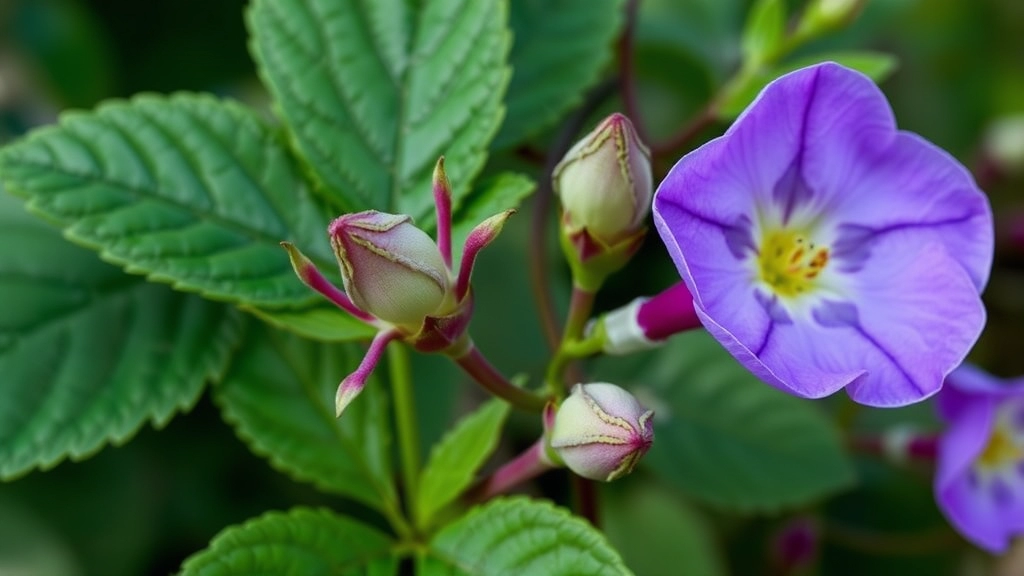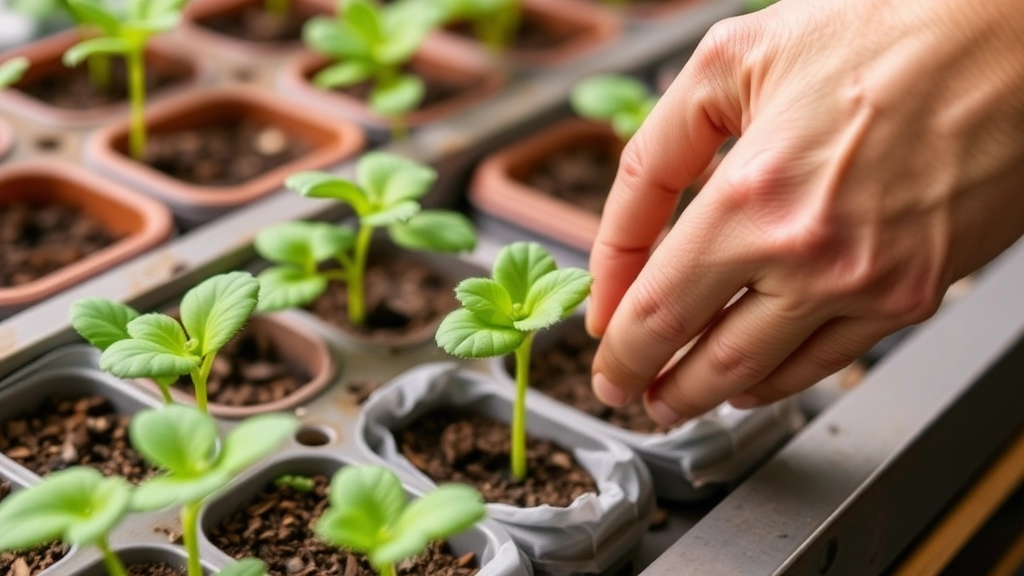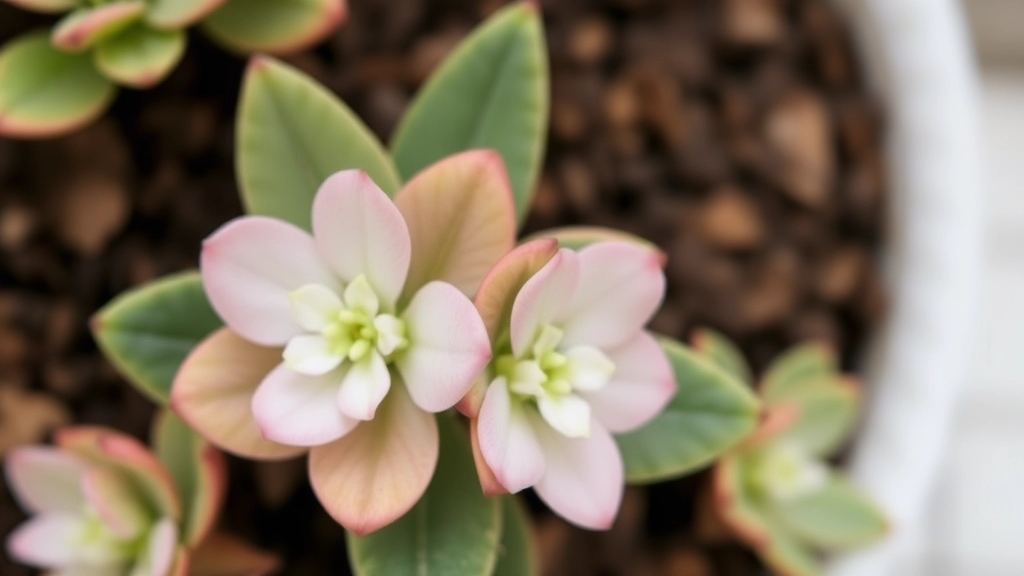Discover the Fascinating World of Kalanchoe Synsepala
Discover the fascinating world of Kalanchoe synsepala, a unique succulent that’s capturing the hearts of plant enthusiasts everywhere. This ‘Walking Kalanchoe’ is not just a pretty face; it’s a botanical marvel with its ability to self-propagate and its striking bluish-green leaves. In this article, we’ll explore its origins, care requirements, and why it’s becoming a must-have for plant lovers.
More Than Meets the Eye
From its low-maintenance nature to its potential medicinal properties, Kalanchoe synsepala offers more than meets the eye. We’ll delve into its ideal growing conditions, propagation methods, and how to keep it thriving in your home or garden. Whether you’re a seasoned gardener or a plant newbie, you’ll find valuable insights on nurturing this charming succulent. Let’s embark on this green journey together!
Overview of Kalanchoe synsepala
Ever heard of Kalanchoe synsepala? It’s a pretty cool succulent.
Let’s chat about this little green wonder.
Kalanchoe synsepala, also known as Walking Kalanchoe, is a unique plant.
It’s part of the Crassulaceae family, which is fancy talk for succulents.
This plant’s got a trick up its sleeve – it can walk! Well, sort of.
It spreads by dropping its plantlets, which then root and grow.
Pretty neat, right?
Originally from Madagascar, it’s now a popular houseplant worldwide.
Why? It’s tough, it’s interesting, and it’s got character.
Plus, it’s not fussy. Perfect for plant newbies or busy folks.
But here’s the kicker – it’s not just a pretty face.
Kalanchoe synsepala has some medicinal properties too.
Traditional medicine uses it for various treatments.
So, you’re getting a plant that’s both eye-catching and potentially useful.
That’s what I call a win-win.
Botanical Characteristics

Let’s dive into the nitty-gritty of Kalanchoe synsepala, shall we? This succulent’s a real head-turner, and I’m gonna break down why.
Physical Appearance
Picture this: a plant that looks like it’s straight out of a sci-fi flick. Kalanchoe synsepala’s got these:
- Thick, fleshy leaves
- A rosette growth pattern
- A unique bluish-green colour
But here’s where it gets wild – the edges of the leaves? They’re lined with tiny plantlets. It’s like nature’s way of saying, “Hey, want more of me? I’ve got you covered!”
Size and Growth Habit
Now, don’t expect this bad boy to take over your garden. It’s pretty chill:
- Typically grows to about 30cm tall
- Spreads to around 60cm wide
It’s not gonna win any races, but slow and steady wins the charm offensive, right?
Flowers
When it comes to blooming, Kalanchoe synsepala doesn’t mess about:
- Produces bell-shaped flowers
- Colours range from pink to orange
- Blooms usually appear in late winter to early spring
Trust me, when these flowers pop, it’s like your plant’s throwing its own little party.
Unique Features
Here’s where Kalanchoe synsepala really shows off:
- Those plantlets I mentioned? They’re not just for show. They’re the plant’s way of reproducing. Talk about efficiency!
- The leaves have a waxy coating. It’s like the plant’s got its own built-in sunscreen.
Look, I’ve seen a lot of plants in my time, but Kalanchoe synsepala? It’s got character. It’s not just another pretty face in the succulent crowd. It’s got tricks up its sleeve and a look that’ll make your mates go, “Hang on, what’s that?”
So, next time you’re eyeing up this beauty, remember – there’s more to Kalanchoe synsepala than meets the eye. It’s a botanical marvel, wrapped up in a compact, eye-catching package. And that, my friends, is why it’s worth getting to know. If you’re interested in other Kalanchoe varieties, check out the Kalanchoe blossfeldiana, which is another popular species.
Ideal Growing Conditions
Ever wondered how to make your Kalanchoe synsepala thrive? Let’s break it down.
Light: These suckers love the sun, but not too much
- Bright, indirect light is the sweet spot
- A few hours of morning sun won’t hurt
- Protect from harsh afternoon rays
Temperature: Keep it cozy, not freezing
- Ideal range: 60-75°F (15-24°C)
- Can handle brief dips to 50°F (10°C)
- Avoid frost at all costs
Soil: Well-draining is the name of the game
- Mix cactus soil with perlite for perfect drainage
- Add some organic matter for nutrients
- Avoid heavy, water-retaining soils
Watering: Less is more, folks
- Let the soil dry out between waterings
- Water deeply, then forget about it for a while
- Cut back even more in winter
Humidity: Not a big deal for these tough plants
- Average room humidity is fine
- No need for misting or humidifiers
- Can handle dry air like a champ
Fertilizer: A little boost goes a long way
- Feed with balanced, diluted fertilizer in spring and summer
- Skip the feeding in fall and winter
- Don’t overdo it – these plants aren’t heavy feeders
Remember, Kalanchoe synsepala is a tough cookie. It’s all about mimicking its natural habitat – sunny, dry, and well-drained. Nail these conditions, and you’ll have a happy plant on your hands.
Propagation Methods

Let’s dive into how you can multiply your Kalanchoe synsepala collection without breaking a sweat. Trust me, it’s easier than you might think!
Leaf Cuttings: The Lazy Gardener’s Dream
I’ve got to tell you, this is my go-to method. It’s so simple, it almost feels like cheating. Here’s how I do it:
- Snip off a healthy leaf
- Let it dry for a day or two (this helps prevent rotting)
- Stick it in some well-draining soil
- Wait for the magic to happen
Boom! In a few weeks, you’ll see tiny plantlets sprouting at the leaf base. It’s like watching your own little Kalanchoe synsepala nursery come to life.
Stem Cuttings: For When You’re Feeling a Bit More Ambitious
If you’re up for a slightly more involved process, stem cuttings are your ticket:
- Cut a 4-6 inch stem just below a leaf node
- Remove the lower leaves
- Let it callous over for a day
- Plant in a mix of peat and sand
- Keep it moist but not waterlogged
Pro tip: I’ve found that dipping the cut end in rooting hormone can give it a real boost. It’s not necessary, but hey, why not stack the odds in your favour?
Division: The “Divide and Conquer” Approach
Got a mature plant that’s looking a bit crowded? Division’s your answer:
- Carefully remove the plant from its pot
- Gently separate the root ball into smaller sections
- Replant each section in its own pot
It’s like giving your Kalanchoe synsepala a fresh start, and you end up with multiple plants. Win-win!
Seeds: The Patient Gardener’s Route
I’ll be honest, I rarely go this route. It’s slow and a bit finicky. But if you’re keen:
- Sow seeds on the surface of well-draining soil
- Keep them warm and moist
- Be patient… like, really patient
Remember, Kalanchoe synsepala propagation isn’t rocket science. It’s all about giving these resilient little succulents the basics they need to thrive. So go on, give it a shot. Before you know it, you’ll be swimming in Kalanchoes! If you’re interested in other Kalanchoe varieties, check out the Kalanchoe tomentosa varieties or learn about the flowering period of Kalanchoe blossfeldiana.
Common Pests and Diseases
Let’s chat about the nasties that can bug your Kalanchoe synsepala.
These tough succulents are pretty chill, but they’re not invincible.
Mealybugs and aphids? Yeah, they’re the usual suspects.
These little pests love to suck the life out of your plants.
Spot ’em early, and you’re golden.
A quick wipe with rubbing alcohol usually does the trick.
Root rot’s another biggie, especially if you’re heavy-handed with the watering can.
Overwatering? That’s a one-way ticket to fungal town.
Keep an eye out for mushy stems or yellowing leaves.
That’s your plant waving a red flag.
Fungal infections can creep in if your plant’s sitting in soggy soil.
Prevention’s your best mate here.
Well-draining soil and proper air circulation are key.
Spider mites might show up if the air’s too dry.
They’re tiny, but they can do a number on your plant.
A good misting or a humidifier nearby can keep them at bay.
Remember, a healthy plant is your best defence against pests and diseases.
Give your Kalanchoe synsepala the right care, and it’ll be tough as nails.
Care and Maintenance Tips
Alright, let’s dive into keeping your Kalanchoe synsepala happy and thriving. Trust me, it’s not rocket science, but a few key pointers can make all the difference.
Watering Wisdom
First things first – water. These succulents are pretty chill about it, but here’s the deal:
- Let the soil dry out between waterings
- Water deeply, but less frequently
- Cut back on water during winter
Pro tip: Stick your finger in the soil. If it’s dry up to your knuckle, it’s time to water.
Light It Up
Kalanchoe synsepala loves basking in the sun, but it’s not a fan of scorching heat. Here’s what you need to know:
- Bright, indirect light is ideal
- Morning sun is great, afternoon shade is better
- If indoors, a south-facing window is perfect
Soil and Feeding
These guys aren’t picky eaters, but they do have preferences:
- Well-draining soil is a must
- Mix regular potting soil with sand or perlite
- Feed with a balanced, water-soluble fertiliser during growing season
Pruning and Grooming
Keep your Kalanchoe synsepala looking its best with these tips:
- Remove dead or yellowing leaves regularly
- Pinch off spent flower stalks
- Trim leggy growth to encourage bushiness
Temperature and Humidity
Kalanchoe synsepala is pretty adaptable, but it does have its limits:
- Ideal temperature range: 15-24°C (60-75°F)
- Can tolerate brief periods below 10°C (50°F)
- Prefers low to moderate humidity
Repotting
Give your plant some room to grow:
- Repot every 2-3 years or when rootbound
- Choose a pot just slightly larger than the current one
- Spring is the best time for repotting
Remember, caring for Kalanchoe synsepala isn’t about perfection. It’s about understanding what makes this plant tick and giving it the basics. Get these care and maintenance tips right, and you’ll have a happy, healthy plant that’ll be the envy of your green-thumbed mates. If you’re interested in other Kalanchoe varieties, check out the Kalanchoe blossfeldiana, a popular flowering species. For those who prefer a unique, fuzzy-leaved variety, the Kalanchoe tomentosa ‘Teddy Bear’ is an excellent choice.
Benefits and Uses of Kalanchoe synsepala
Ever wondered why Kalanchoe synsepala is more than just a pretty face?
Let’s dive into the perks of having this succulent around.
Firstly, it’s a champ at purifying air.
Yep, it’s like having a natural air freshener in your home.
But that’s not all.
This plant is tough as nails, perfect for busy folks or those with a not-so-green thumb.
It’s also a mood booster.
The vibrant colours can brighten up any room and lift your spirits.
Got a small space?
No worries.
Kalanchoe synsepala is compact, making it ideal for apartments or offices.
Here’s a quick rundown of its uses:
- Indoor decoration
- Outdoor landscaping
- Gift-giving
- Medicinal purposes (in some cultures)
But wait, there’s more!
It’s a great conversation starter.
Trust me, your mates will be asking about this unique plant.
And for the crafty folks out there, its leaves can be used in DIY projects.
Bottom line?
Kalanchoe synsepala is a versatile plant that brings beauty and benefits to your space.
It’s not just a plant, it’s a lifestyle upgrade.
So, ready to add some Kalanchoe synsepala magic to your life?
Frequently Asked Questions
Let’s dive into some burning questions about Kalanchoe synsepala, shall we? I’ve been growing these beauties for years, and I’ve heard it all. So, let’s cut through the noise and get to the good stuff.
Q: How often should I water my Kalanchoe synsepala?
A: Here’s the deal: these succulents are tough cookies. They’re not fans of soggy feet, so I usually go by the “less is more” rule. I stick my finger in the soil – if it’s dry about an inch down, it’s watering time. In summer, that might be once a week. Winter? Maybe once a month. Easy peasy.
Q: Can I grow Kalanchoe synsepala indoors?
A: Absolutely! These plants are like chameleons – they adapt. Just give ’em a sunny spot near a window, and they’ll be happy campers. But remember, they’re not fans of drafts or sudden temperature changes. Keep ’em cosy, and they’ll thrive.
Q: How big do Kalanchoe synsepala plants get?
A: These guys are pretty modest in size. In my experience, they usually top out at about 30-40 cm tall and wide. Perfect for that empty spot on your bookshelf or coffee table.
Q: Is Kalanchoe synsepala toxic to pets?
A: Here’s the scoop – like many Kalanchoes, this one can be toxic if ingested. If you’ve got curious cats or dogs, it’s best to keep these plants out of reach. Better safe than sorry, right?
Q: How do I propagate Kalanchoe synsepala?
A: It’s a piece of cake! These plants are propagation pros. You can:
- Take a leaf cutting and let it callous over
- Snip off a stem and pop it in some well-draining soil
- Or, if you’re lucky, you might spot some plantlets growing on the leaf edges – just pluck ’em off and plant ’em
Q: Why are my Kalanchoe synsepala leaves turning yellow?
A: Ah, the dreaded yellow leaf. Usually, it’s down to one of these culprits:
- Overwatering (the most common issue)
- Not enough light
- Nutrient deficiency
My advice? Check your watering habits first, then consider moving it to a brighter spot.
Q: How often should I fertilise my Kalanchoe synsepala?
A: These plants aren’t big eaters. I give mine a light feed with a balanced, water-soluble fertiliser once a month during the growing season. In winter, I let them rest and skip the fertiliser altogether.
Remember, every Kalanchoe synsepala is unique, just like us. What works for one might not work for another. The key is to observe your plant, learn its quirks, and adjust your care accordingly. Happy growing!
Frequently Asked Questions about Kalanchoe synsepala
Q: What makes Kalanchoe synsepala unique?
A: Kalanchoe synsepala, also known as Walking Kalanchoe, is unique due to its ability to propagate itself by dropping plantlets from its leaves. This “walking” characteristic, combined with its attractive bluish-green leaves and low-maintenance nature, makes it a standout among succulents.
Q: How do I care for Kalanchoe synsepala indoors?
A: To care for Kalanchoe synsepala indoors:
- Place it in bright, indirect light
- Use well-draining soil
- Water sparingly, allowing the soil to dry between waterings
- Maintain temperatures between 60-75°F (15-24°C)
- Fertilize lightly during the growing season
Q: Can Kalanchoe synsepala survive outdoors?
A: Yes, Kalanchoe synsepala can thrive outdoors in USDA zones 9-11. It prefers partial shade and protection from harsh afternoon sun. In colder climates, it’s best grown as a container plant that can be moved indoors during winter.
Q: How often does Kalanchoe synsepala bloom?
A: Kalanchoe synsepala typically blooms in late winter to early spring. The bell-shaped flowers range from pink to orange. However, the plant is primarily grown for its interesting foliage rather than its flowers.
Q: Is Kalanchoe synsepala toxic?
A: Like many Kalanchoe species, Kalanchoe synsepala can be toxic if ingested. It’s best to keep it out of reach of pets and children. If you suspect ingestion, contact a medical professional or veterinarian immediately.
Q: How can I propagate Kalanchoe synsepala?
A: Kalanchoe synsepala is easy to propagate. You can:
- Use leaf cuttings
- Collect and plant the plantlets that form on leaf edges
- Take stem cuttings
All methods involve allowing the cutting to callous over before planting in well-draining soil.
Q: What are some common problems with Kalanchoe synsepala?
A: Common issues include:
- Overwatering, leading to root rot
- Mealybugs or aphids infestation
- Etiolation (stretching) due to insufficient light
- Leaf drop from extreme temperature changes
Most problems can be prevented with proper care and attention to the plant’s needs.
References
-
Missouri Botanical Garden – Kalanchoe synsepala Plant Finder: Kalanchoe synsepala
-
World of Succulents – Kalanchoe synsepala Kalanchoe synsepala (Walking Kalanchoe)

